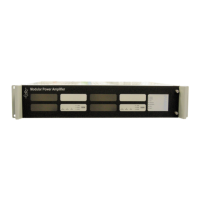iPAM400 – Product Manual
U-0629-0171.doc – Issue: 04 complete, approved
Page 22 of 138
2.4.5 Loudspeaker Line Earth Leakage Monitoring
Both loudspeaker line phase conductors are monitored for resistance to earth. No current flows to earth
when the loudspeaker wiring is intact. Current will flow and an earth fault will be reported when the
loudspeaker wiring is faulty or there is ingress of water.
The earth resistance fault threshold is 50 kΩ. This value allows minimal water ingress to be tolerated,
minimising ‘nuisance’ fault reports.
The faulty loudspeaker circuit within an amplifier can be identified in the case of a single earth fault.
2.5 Auxiliary Control
The Auxiliary Control is optionally fitted into the rear panel with one of the following modules:
• GSM-R (Global System for Mobile communications – Railway) module
This provides GSM-R connectivity. (Future development)
• DTMF (Dual-Tone Multi-Frequency) module
Future development. This provides DTMF connectivity. (Future development)
• Audio I/O Expansion Module
This provides additional audio inputs (two) and low level audio outputs (four).
Note that if the Listen-in function is configured only one audio input will be available, as the Listen-in
function requires the internal one of the audio input internal connections.
The Controller (Section “2.1 Controller”, page 11) provides the required internal interface for connection of
the Auxiliary Control module.
2.6 Fault and Status Monitoring
The iPAM400 reports its current announcement and fault status via a JCOP/JPC interface
1
over TCP/IP to
the control system, which can then provide the appropriate indication to the user. The iPAM400 uses the
same method to report the status of any external fault inputs connected to a BMB01 Remote I/O Unit; see
Section “2.1.2.8 BMB01 Remote I/O Unit” (page 13).
2.7 Commissioning and System Maintenance
System commissioning can be carried out by:
• A PC connected to the RS232 port on the iPAM400.
• A PC connected to the iPAM400 across the IP network.
• A monitor and keyboard directly connected to the iPAM400.
Software and configuration update can also be provided by these methods.
1
JCOP is a network-transparent IPC mechanism using the QDatastream-printable format for marshalling and the XMPP (Jabber)
protocol for transport.
JPC is a JCOP term used to describe a status tree published by a JCOP process.
IPC = Inter-Process Communication
XMPP = Extensible Messaging and Presence Protocol

